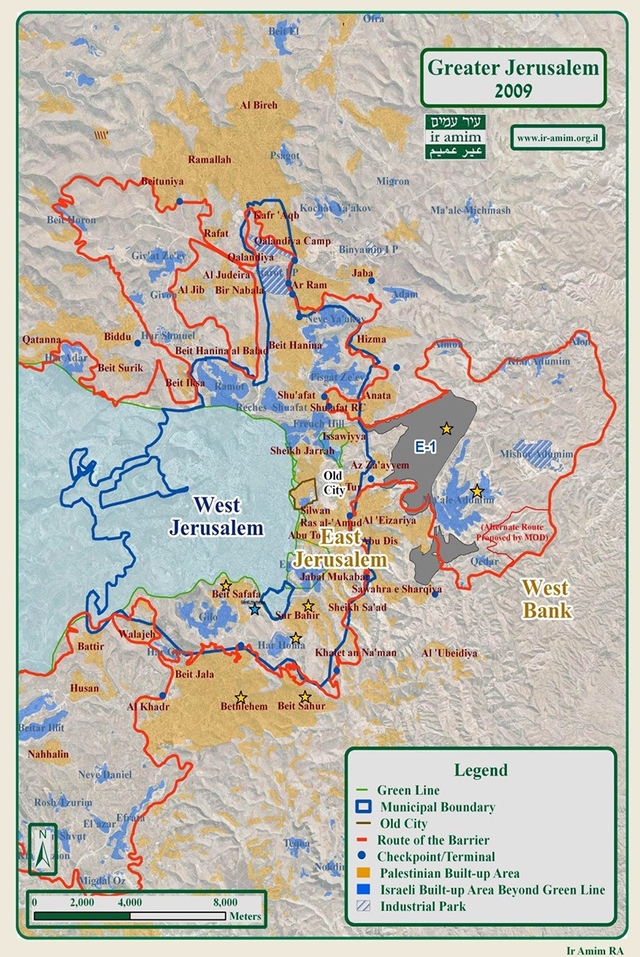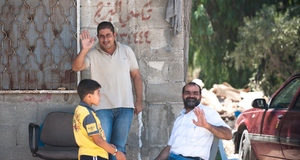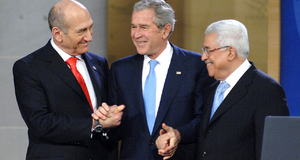From Interstate - Journal of International Affairs VOL. 2014/2015 NO. 1Can One Side of the Coin Be More Equal than the Other: Greater Jerusalem and its 'Settlements'/'Neighbourhoods'
By
Interstate - Journal of International Affairs 2015, Vol. 2014/2015 No. 1 | pg. 1/1
KEYWORDS:
If I belonged to the majority of the Israeli public I might call this paper ‘A journey along an Israeli neighbourhood – discovering the many sides of Jerusalem’. If my origins were different, perhaps the title would be: ‘The issue of Israeli settlements – the division of Jerusalem?’ If I came from the so-called ‘Western World’, my vocabulary might include the term ‘Separation Wall’ but, if my home was in Israel, I might prefer to talk about the ‘Jerusalem envelope’ or ‘Security Fence’. Where I come from may not matter if I go to a place of interest, experience its reality and meet people who will influence my viewpoints. Perhaps, I will realise how little I knew or how restricted the lines of my knowledge and imagination were. After some time the crucial factor can become where I have been, what I have experienced went to and how much I have changed since then. The thought of Jerusalem brings to my mind not only the image of the Old City and its holy places which are the main subjects of a visit to Israel. What becomes apparent as one travels along, are Israeli and Palestinian ‘neighbourhoods’, the differences between them, the passionate words of our guides and tracing step by step the map of the ‘settlement project’.1 The road along the settlements changes constantly – at once you can drive along wide streets with pavements on either side, to appear suddenly on destroyed roads without space for pedestrians. The on-going changes to the landscape make you wonder whether you are still travelling within the boundaries of the same area. Then you analyse who should be held responsible for this clear inequality, who you should question and what are the reasons behind it. Yet, you take a long breath and think: ‘thankfully I do not belong to either side. Maybe I will manage to see both sides of the coin’. The thought of Israel reminds me of one more crucial issue – the importance and sensitiveness of every conceived and spoken word. There are times when one’s seemingly trivial expression can place you in the position of being a defender of some, and an enemy or opponent of others. In this case those words are: ‘settlements’ and ‘neighbourhoods’. The phenomenon that takes place in East Jerusalem is named by the Israeli government, many Israelis and some secondary observers as the ‘neighbourhood project’. For most Palestinians, some Israelis and the majority of international opinion the relevant name is ‘settlement project’. Depending on whose opinion is brought to the discussion table, those two terms are used interchangeably to describe the same issue. The project of building ‘Israeli settlements’ in East Jerusalem, which started after the Six Day War, is officially a private investment project without direct or open government support. Nevertheless, it is openly argued that the government unofficially supports the project despite the questions raised about not only separating Israelis and Palestinians, but also Palestinians from Palestinians, dividing Jerusalem, attempting to gain the control over the Old City by Jewish settlers as well as acting against the idea of a ‘two state solution’. Since 1967, 30 per cent of East Jerusalem land was disposed in order to build Israeli ‘neighbourhoods’.2 In December 2012, the organisation Americans for Peace Now (APN) reported on a few recent developments regarding ‘settlements’.3 Following the United Nations General Assembly vote, on 29 November 2012, that granted Palestine non-Member Observer State status in the UN,4 the Netanyahu government declared its support for the building of up to 3,000 homes in Jerusalem and for planning the E1 area.5 Additionally, APN reported plans for 6,600 units in East Jerusalem including building in Givat Hamatos, Ramat Shlomo and Gilo. The APN noted the danger for Palestinian families who would be removed from their homes in Sheikh Jarrah in order to allow settlers to move in.6 Following the impressions from my visit to Israel and relying on my own research, I will briefly present the two main settlement projects which are E1 and Maale Adumim, together with Har Homa and Givat Hamatos (marked with stars on the map below). E1 (‘East 1’) is a term introduced by the Israeli Ministry of Housing to an area that belongs to the West Bank and is located between the eastern municipal boundary and Maale Adumim. This term also refers to the Israeli intention to build a ‘neighbourhood’ that includes, among other things, construction of 3,500 or more residential units, the transfer of the West Bank Police Headquarters from its present position and building an industrial area.7 For Israelis, building on E1 would prevent the Maale Adumim ‘neighbourhood’ from being isolated and would also connect this ‘settlement’ to Jerusalem. However, many oppose this project. First of all, Maale Adumim is built beyond the Green Line, on the West Bank territory which, according to international law, defines it as a settlement. Secondly, there is some agreement that the E1 construction would likely hamper any hope for a ‘two-state solution’. It would divide the West Bank into Northern and Southern parts, disrupting the unity of the land and, therefore, a future Palestinian state. Furthermore, it would ‘disconnect’ Palestinians living in the West Bank with East Jerusalem. As a result, the Old City of Jerusalem and its holy places would be less accessible.8 It has to be noted that the possible ‘two state solution’ recognises Jerusalem as a neutral land and capital of both states.9 The Givat Hamatos ‘neighbourhood’ plans are based to the south of Jerusalem, between Beit Safafa and Bethlehem. This is the first new Israeli ‘neighbourhood’ in East Jerusalem since the building of Har Homa in 1997. The previous project was strongly opposed by Palestinians as it lay in the middle of an existing Palestinian built-up area and in-between Bethlehem, Beit Sahur and Sur Bahar ‘neighbourhoods’ (see the map above). The new ‘neighbourhood’ would isolate Bethlehem from East Jerusalem and, again, destroy the continuity of Palestinian land10. As reported by the Ir Amim organisation, the building plan is divided into four sections:
A CNN report has quoted Israeli Prime Minister Benjamin Netanyahu as saying that the ‘neighbourhood project’ is the continuation of the building process in the ‘capital of the Jewish people’ carried out by all Israeli governments.12 Additionally, a Jerusalem Post analysis of a Washington Post article argues that the idea that the Israeli ‘settlements’ are the main obstacle to the peace process is misleading. It says that the Israeli Prime Minister limited the building project ‘almost entirely to areas that both sides expect Israel to annex through territorial swaps in an eventual settlement’ and therefore Israeli ‘settlements’ are planned on the space that would become part of Israel in the future peace agreement.13 Moreover, there is an argument that the ‘settlement’ project is a natural response to the need to supply housing for a fast growing population.14 Nevertheless, voices are increasingly being raised against Israeli construction in East Jerusalem. As a CNN report states, the project is carried out on the area that was hoped by Palestinians to become their capital in a future Palestinian state that would include Gaza and the West Bank. The annexation of East Jerusalem by Israel after the 1967 Six Day War was never accepted by international opinion and the Palestinians, who considered it as an act against a future peace agreement.15 Ir Amim’s director Yehudit Oppenheimer said in a talk that most people focus on the Israeli right, or lack thereof, to build beyond the Green Line. However, there is a much more important issue that touches people living on those territories. As Oppenheimer says: ‘This reality traps within it a large Palestinian population, with all its religious and symbolic assets, with no civil status and with no rights, while the Jewish majority has a monopoly on the mechanisms of power and control’.16 One of the Israeli government’s biggest contributions to ‘settlement’ projects is state funding of security for East Jerusalem settlers. The Israeli government spends an average of NIS 38 million per year - a budget which comes from the Ministry of Housing - to protect 2000 settlers. In 2008, the Israeli Knesset approved an additional NIS 15 million for settler security.17 Another problem is inequality between the citizens of East Jerusalem, despite their common status as residents of Israel. On the one hand, Palestinians receive various benefits thanks to their status, including the right to live and work in Israel without special permits, entitlement to social benefits and health insurance. However, on the other hand, by not considering themselves as Israelis, they face many obstacles. For example, Palestinian residents cannot vote in elections for the Israeli government and they are not have ensured the right to return to Israel at any time, in case one leaves the country.18 Furthermore, one of the main issues is a municipal inequality which mainly touches two areas. These are obstacles to the physical development of the Palestinian neighbourhoods, such as failing to draw up outline plans; and the problem of education. In 2009 there was a shortage of more than 1000 classrooms; about half of the parents of Palestinian children were forced to send their children to private education and about 5,500 Palestinian children do not go to school at all. These and many other issues are subject to disputes between both sides and their supporters. This paper is the result of what I have learned and experienced. Yet, it presents merely a few pieces of the large picture and traces some of the issues connected to the ‘settlement project’. These and many more issues remain. Therefore it can be treated as an introduction and encouragement for further investigation of the topic. On my visit, I did not belong to either of the sides; I have ignored the thought of where I came from and what I brought with myself; I allowed myself to be fully impacted on by the environment around me. I heard numerous opinions, facts and arguments but when I think of the strongest memory of this particular experience, I have in front of my eyes the picture of that constantly changing road and its surroundings. I look, then, at both sides of the coin and have this unnatural impression that despite the fact that it is a single coin, one side seems to be more equal than the other. ReferencesAgence France Presse, ‘Settlements block Jerusalem as capital of two-states’. EU Arab News (online), 27 February 2013. Available at: http://www.arabnews.com/middle-east/settlements-block-jerusalem-capital-two-states-eu. Americans for Peace Now, ‘Settlement round-up: Thousands new homes planned for East Jerusalem, West Bank’. APN (online), 27 December 2012. Available at: http://peacenow.org/entries/972_settlement_round-up_thousands_new_homes_planned_for_east_jerusalem_west_bank#.Udr6CEHUki8. B'Tselem - The Israeli Information Center for Human Rights in the Occupied Territories, ‘Legal Status of East Jerusalem and its Residents’. B'Tselem (online), 1 January 2013. Available at: http://www.btselem.org/jerusalem/legal_status. Eldar, A ‘New neighborhood on the way between Jerusalem and Bethlehem’. Al-Monitor (online), 17 December 2012. Available at: http://www.al-monitor.com/pulse/originals/2012/al-monitor/new-neighborhood-on-the-way-betw.html. Friedman, L ‘What You Need to Know About E-1’. APN (online), 7 December 2012. Available at: http://peacenow.org/entries/post_69#.UPMuSI1lRdm. Hasson, N ‘Construction in Jerusalem neighborhoods beyond Green Line peaked in 2012’. Haaretz (online), 3 January 2013. Available at: http://www.haaretz.com/news/national/construction-in-jerusalem-neighborhoods-beyond-green-line-peaked-in-2012-1.491549. Ir Amim. ‘State Funding of Security for East Jerusalem Settlers’. Ir Amim. Available at: http://eng.ir-amim.org.il/?CategoryID=301. Ir Amim, ‘On Israeli construction in East Jerusalem’. Ir Amin. Available at: http://eng.ir-amim.org.il/?CategoryID=289. Used with permission. Ir Amim, ‘What is E-1?’ Ir Amim. Available at: http://eng.ir-amim.org.il/?CategoryID=180. Ir Amim ‘2500 new housing units approved for Givat Hamatos’. IA. Available at: http://eng.ir-amim.org.il/?CategoryID=313. JPOST.COM STAFF ‘'Wash. Post': Settlements not main peace obstacle’. Jerusalem Post (online), 1 Febrary 2013. Available at: http://www.jpost.com/MiddleEast/Article.aspx?id=298171. JPOST.COM STAFF ‘Editorial: The logic of E1’. Jerusalem Post (online), 12 Febraruy 2012. Available at: http://www.jpost.com/Opinion/Editorials/Article.aspx?id=294327. Sidner, S ‘Israel says it will build settlements in East Jerusalem neighborhoods’. CNN (online), 20 December 2012. Available at: http://edition.cnn.com/2012/12/20/world/meast/israel-settlement-plans/index.html. United Nations General Assembly, Sixty-seventh General Assembly, General Assembly Plenary, 44th & 45th Meetings (online) 29 November 2012. Available at: http://www.un.org/News/Press/docs/2012/ga11317.doc.htm. Endnotes
Suggested Reading from Inquiries Journal
Inquiries Journal provides undergraduate and graduate students around the world a platform for the wide dissemination of academic work over a range of core disciplines. Representing the work of students from hundreds of institutions around the globe, Inquiries Journal's large database of academic articles is completely free. Learn more | Blog | Submit Latest in Political Science |
















